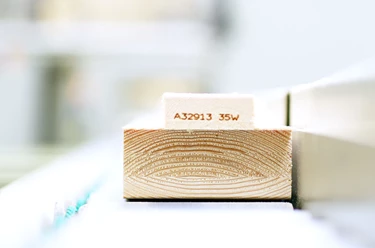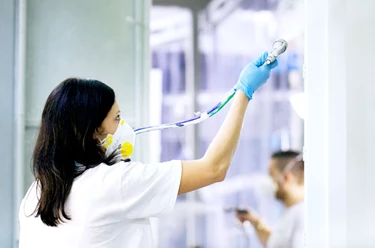
The wood in our frames constitutes around 20% percent of every window. We only use northern European FSC®-certified wood to manufacture our windows and doors, sourced from responsably managed forests. Also all wood treatments are water based, to reduce the amount of chemicals used.
Wood is a renewable resource which can be reused again and again, for example to produce new window frames, furniture, wooden boards or chipboards.
Compared to other commonly used building materials, wood is less energy-intensive to produce. Trees grow using the natural forest resources of CO2, solar energy, water and minerals
Wood is a CO2-neutral resource which means that there is a balance between the amount of CO2 that the tree takes up while it is growing and the amount that it releases during its disposal. Using photosynthesis, trees produce the oxygen that we humans breathe in every day. At the same time, they remove some of the CO2 in the air, which would otherwise contribute to the greenhouse effect. This is due to the fact that trees absorb CO2 from the atmosphere and store it as carbon before they are cut down and again when they are processed as, for example, building materials.

The VELFAC 200 series consists of 9.4%. aluminium, which is used for our windows external frames. 2/3 of the aluminium used in VELFAC profiles is manufactured using renewable energy.
In addition to its strength-giving properties and high tensile and breaking strength, aluminium is extremely durable and virtually maintenance free, therefore very little maintenance is required on the external frames of our windows and doors for the lifetime of installation.
Aluminium is a precious resource and a highly sustainable material,as it is suitable for recycling and can be reused indefinitely with a very limited loss of its properties.
The vast majority of aluminium is collected and reprocessed instead of being newly mined. In Europe, more than 80% of aluminium building materials are reused.
By remelting the aluminium, greenhouse gas emissions are reduced by 95%, as the energy consumption is limited to a maximum of 5% of the quantities used for new production. The production process generates a small amount of aluminium cuttings, which are also remelted for recycling.
Recycled aluminium can be used in a wide range of products, for example food packaging, transport, technology and building materials.

Glass constitutes 62.2% of a VELFAC window. VELFAC manufactures double and triple glazing windows and the cavity between each pane of glass is filled with a non-toxic inert gas called Argon. Argon is extracted directly from the atmosphere and is nature's most common noble gas. Argon makes up 0.1% of a VELFAC 200 window and thanks to its excellent insulating properties, our windows are able to dramatically reduce the heat loss through the glass.
Glass is made from abundant and easily available raw materials: sand, lime and soda.
The main characteristics of glass are transparency, heat resistance, pressure, breakage resistance and chemical resistance. Thanks to these properties, glass has a very long life and is highly suitable for recycling. Glass recycling requires about seven times less energy than the production of new glass, so it makes an important contribution to the reduction of CO2 emissions in the construction industry.
In Europe, used glass products are collected, recycled and given a new life. For example, glass can be reused for manufacturing new windows or kitchenware. Sometimes, glass is crushed and used as insulating glass wool in buildings.

The VELFAC 200 series consists of 1.8% steel, used in the hinges of our windows and to hold the frames in place.
The VELFAC 200 series also consists of 0.5% zinc used in the windows fittings.
Steel is the most commonly recycled material in the world, and it can be reused again and again without any loss of quality. Steel has a number of properties that make it suitable for recycling, like, above all, its magnetic properties, which contribute to streamlining the sorting process in connection with recycling. Furthermore, it takes far less energy to recycle steel than any other metal, and this can be then reused as metal sheets, steel chips or be reprocessed and adapted to be used again as building material.
Zinc is a naturally occurring metal which is extracted from ore. Zinc is one of the most common metals in the world, and requires low energy consumption to be produced. It is maintenance-free and also has a long service life. In addition, zinc has the lowest CO2 emissions compared to other building materials. At the same time, it is a frequently recycled materials as it can be recycled up to 100% without affecting its properties.
Zinc's recycling properties are undeniable, and in fact more than 96% of all zinc in use today is recycled .

We use small amounts of PVC which, together with other plastics, constitutes 2.25 of our windows and doors. PVC – also known as polyvinyl chloride – is produced using crude oil and sodium chloride (salt). PVC is one of the most widely used plastic materials in the world, especially by the construction industry which accounts for more than half of all consumption of PVC. PVC is known for its extreme durability and excellent insulating properties. It is also easy to handle and process.
PVC is fully recyclable and can be remelted in order to produce raw materials that can be used in new products. In Europe, the recycling of PVC is longstanding and widespread. Approximately 75% of all hard PVC construction waste is recycled and reused to manufacture, for example, pipes and other building materials.

While around 93% of a VELFAC 200 products consists of components that are fully recyclable, they also contain a small percentage of residual materials that can either not be recycled or only recycled to a limited extent. These include materials found, for example, in the glue or the surface treatments applied to the frame and fittings.
We apply varnish, water-based wood protection and paint to the frame of our windows and doors. The surface treatment makes up a total of 0.4% of a window, and is applied to extend the durability of the components by protecting them from mechanical wear and tear, moisture and UV rays.
The surface treatments we use for our products have been selected with the greatest possible consideration for people as well as the environment. This means that we strive to use varnishes, wood preservatives and paints that are low in solvents and other harmful substances.
When the window is disassembled, the surface treatment is stripped from the aluminum. The surface treatment applied to the wood become part of the recycling process.
Thermal glue and wood glue are used in the making of our products and they constitute 0.2%. The thermal adhesive is used as a reinforcing sealant between the pane and the frame. This ensures optimal window stability and burglary protection. The wood glue is used on the frame to hold the corners of the frame together and to make the window tight.
We only use the most environmentally friendly glue on the market for our products. This means that all glue that is applied to our windows has the least possible impact on both people and the environment. At the same time, we are constantly trying to find new and even more environmentally friendly adhesive products.